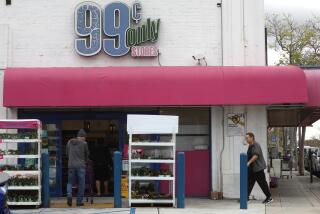Surging Music Retailer Has Little to Fret About
- Share via
AGOURA HILLS — In a performance worthy of a “Behind the Music” profile on VH-1, Guitar Center stock posted a strong comeback in the third quarter to finish as one of the biggest gainers among San Fernando Valley-based public companies.
The company’s stock, which sank to a 52-week low of $7.88 in November, closed Friday at $12.31--up 17.26% for the quarter and 30.46% over 12 months. The increase came even as shares in many retailing firms were pummeled by rising interest rates and higher energy costs.
“The company put a couple of solid quarters together that propelled the stock after some rougher sledding,” said Matthew Fassler, an analyst for Goldman, Sachs & Co. “Guitar Center has made its number and that’s been the primary change of the direction here.”
Last month, the Agoura Hills-based firm reported net income of $4.1 million in its fiscal second quarter ended June 30, compared with a net loss of $149,000 for the same period last year. Revenue rose to $178.6 million from $139.2 million.
Same-store sales increased 7%, or $8.6 million, compared to the year-earlier period.
Strong earnings, a resurgent retail business and moderating growth by rivals, were behind Guitar Center’s rising fortunes, analysts and company officials said.
Company executives also said it was reaping benefits from last year’s merger with Musician’s Friend Inc., the largest catalog and Internet retailer of musical instruments in the U.S.
Another reason for the turnaround could be found in the armloads of merchandise that Josh Stevens had as he recently walked out of the Guitar Center Store on Ventura Boulevard in Sherman Oaks recently.
Stevens, 24, said he spent several thousand dollars during a number of trips to the store this summer to buy instruments and production equipment.
“I’ve bought a synthesizer, production software and everything else that lets me record music and make CDs,” said Stevens said. “Guys like me who aren’t pros can use this to make music from the ideas in my head.”
*
Besides younger customers, Guitar Center’s Marty Albertson, a co-chief executive officer, said baby boomers are helping drive a $5-million-a-year business in vintage used instruments.
Boomers are eager to buy that 1961 Fender Stratocaster they always wanted or an old tube amplifier to recreate the sound of their youth.
And if they can’t afford the real thing, instrument and amplifier manufacturers also are turning out reissues of classic designs.
“The baby boomer generation has been great for our business,” Thomas said. “They’ve been buying high end.”
Whether its older music lovers or a younger generation buying up digital and deejay equipment, second- and third-time buyers have been a driving force behind the company’s success, says Larry Thomas, Guitar Center chairman and co-chief executive.
So are the rapid developments in music technology, which have buyers like Stevens looking to update their equipment as soon as new products hit the market.
“The technology has gotten better and more inexpensive, just like in the PC business,” Thomas said. “It enables a lot of guys to do in their house what they had to drive around and spend a lot of money to do.”
Guitar Center’s flagship store in Hollywood, which houses a renowned vintage guitar collection, is also home to the Rock Walk, a Sunset Boulevard tourist mecca paying homage to more than 70 musicians.
Founded 37 years ago, the company went public in 1996 with 27 stores in 14 major markets. It has grown to 78 stores in 35 markets with average retail space for each outlet of 16,000 square feet.
The number of stores is expected to expand to 83 outlets by the end of the year, Thomas said. Another 20 are expected to be added in 2001.
Each store carries about 7,000 items, from drum kits to guitar strings.
Audio equipment and accessories account for 38% of sales, keyboards and pianos 21%, guitars 14%, sheet music 7%, amplifiers 6% and percussion gear 3%, the company said.
*
During the slide in the company stock price, some critics questioned a growth strategy built on opening more stores amid growing competition from rivals such as privately held Music and Recording Superstore (MARS) and Sam Ash.
Others wondered whether the company was running up too much debt as it rolled out new stores.
But company executives said those concerns were overblown.
Rather than cannibalize business, Albertson said, the company was finding it could create a larger market for music, which now totals about $7.1 billion nationwide.
Not counted in that market, Albertson said, is professional audio rental and repair, instrument modification and customization, and sales of used equipment and instruments.
As for questions about cash flow, executives said that was not an issue.
“We have minimum start-up costs at our stores and they are profitable from one to three months [after opening],” Albertson said.
Goldman’s Fassler says growth prospects are strong.
“Guitar Center is one of a shrinking number of true growth retailers that can expand domestically with a core concept for an extended period of time.”
More to Read
Inside the business of entertainment
The Wide Shot brings you news, analysis and insights on everything from streaming wars to production — and what it all means for the future.
You may occasionally receive promotional content from the Los Angeles Times.










